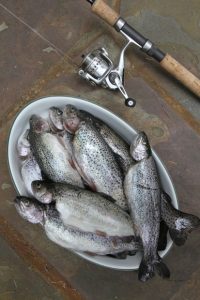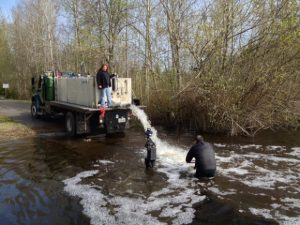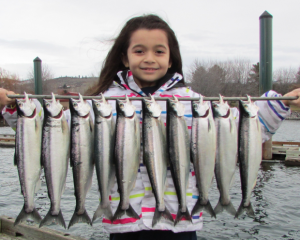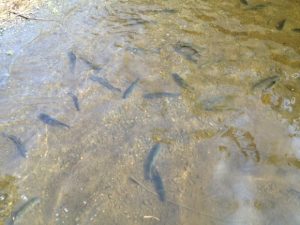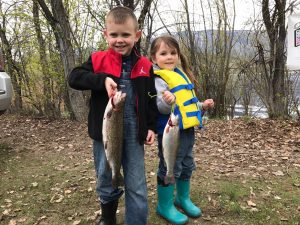Trout-fishing mania begins with statewide lowland lakes opener April 28-29 Leave a reply
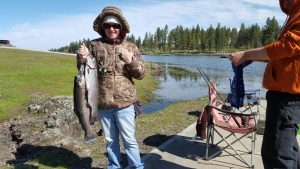
A happy angler in 2017 landed this large trout on opening day at West Medical Lake in Spokane. Look for plenty of fun in hundreds of statewide lakes on the April 28-29 opener that will also carry on into spring, summer and beyond. Photo courtesy of Bruce Boulding at WDFW.
Spring is marker when the sun rises earlier and earlier over the eastern horizon, the days are getting a lot longer, the flowers and trees are blooming and so are the trout fishing opportunities.
Thousands and thousands of anglers are prepping their fishing gear for the traditional statewide lowland lakes trout opener on April 28-29.
Anglers will be happy to know the Washington Department of Fish and Wildlife (WDFW) hatchery crews have been busy prepping more than 500 statewide lakes and ponds that will be planted with a whopping 16,840,269 trout.
“We have been busy with spring trout plants and our projected plant is 461,100 for this region (Puget Sound area lakes, plus 5,728,993 fingerling planted in 2017),” said Justin Spinelli, a WDFW biologist in Mill Creek. “We will have a good spring and summer trout fishing and an excellent transition to warm water fishing later in the summer.”
Several years ago, WDFW concocted a cost-effective way to produce larger catchable-sized trout in hatcheries, which has been well-received by anglers surveyed on previous openers.
The updated standardized size of the trout is about 11 inches compared to 8-inches in previous seasons. Just like in 2017, anglers should find 2,171,307 catchable-sized trout lurking around in lakes.
Another 124,133 “jumbo” trout measuring 14 or more inches long and one pound or larger in weight will also be going into hundreds of statewide lakes.
Add to that another 12.9 million of trout fry, fingerlings and smaller-sized trout stocked last spring and fall, which should now be 8 to 12 inches long and you’ve got a great chance to bring some home for dinner.
The survival rate of fingerlings largely depends on water conditions, and this winter wasn’t too cold and with enough feed this spring look for these fish to be fattening up in time for the opener. A good number of Eastern Washington lakes see very good fry survival and are usually the main source of the catch during spring time.
In King County, 12 lakes will be stocked with trout for opening day. They are Cottage, 12,000 trout (2.2 fish per rod average last year on opening day – five trout is a daily limit); Geneva, 5,500 (4.6); Langlois, 5,000 (2.8); Margaret, 5,000, plus 9,000 cutthroat fry last fall (4.6); Mill Pond, 900; North, 9,500 (4.6); Old Fishing Hole, 250; Pine, 12,000 (3.3); Shady, 3,400; Steel, 8,000 (4.9); Walker, 2,500 (2.1); and Wilderness, 12,000 (2.7).
Elsewhere in the Puget Sound region, seven lakes in Pierce County will be stocked for opening day; four in Skagit County; 12 in Snohomish County; six in Whatcom County; four in Grays Harbor County; three in Thurston County; seven in Kitsap County; three in Pacific County; two in Island County; six in Jefferson County; seven in Kitsap County; 17 in Mason County; and one in San Juan Island County.
Other notable lakes during last year’s opener were – Island County: Deer, 3.4. Skagit County: Erie, 4.2; Heart, 2.6; McMurray, 3.3; and Stevens, 6.2 (catch average was over the legal limit). Snohomish County: Bosworth, 3.4; Howard, 3.5; Ki, 3.4; Martha AM, 4.2; Serene, 3.0; and Wagner, 3.6. Whatcom County: Cain, 3.9; and Toad, 3.2. Pierce County: Bay, 4.9; and Clear, 3.09. Thurston County: Clear, 3.07; Hicks, 3.03; Pattison, 3.76; and Summit, 3.69. Lewis County: Carlisle, 4.25; and Mineral, 2.7.
In Eastern Washington the top lakes were Cedar, 4.59 and Waitts, 3.13 in Stevens County; Jameson, 2.26 in Douglas County; and Wapato, 4.62 in Chelan County.
For anglers who can’t wait and want to get a jump start on trout fishing, there are hundreds of lakes open year-round and many were recently stocked.
Locally, try Alice, Angle, Beaver, Desire, Green, Rattlesnake, Meridian, Morton, Spring, Twelve and Sawyer in King County; Ballinger, Tye, Blackmans, Flowing, Chain, Gissburg Ponds, Goodwin, Ketchum, Lost, Martha, Panther, Roesiger, Shoecraft and Silver in Snohomish. Spencer and Island in Mason County. St. Clair and Black in Thurston County. Tanwax, Spanaway and Bonney in Pierce County. Snag and Western in Pacific County.
A downer for anglers seeking bigger fish is no triploid plants will occur statewide due to budget constraints by WDFW during this biennium, which extends not only for 2018 but 2019 as well.
“The big change to our spring trout fishing season is there will not be any jumbo triploid plants as we identified a big hole in our budget,” said Steve Thiesfeld, the WDFW inland fish program manager.
“In the end we needed to make a few million dollars in reductions and one was the triploid program for the biennium,” Thiesfeld said. “Hopefully we will have a better go at for the next round although that next round won’t occur until this biennium ends as of June of 2019. We hope to have some relief after that point.”
“The triploid program is a direct purchase we do from Trout Lodge (a private fish growing company) and it was an efficient way to cut a program. It is always a difficult thing to take a piece of something that has been a success for our spring trout fisheries.”
In past year, like 2017 a total of 42,000 triploid trout averaging 1½ pounds apiece were planted for the opener into west side lakes. Triploids are sterile trout that can grow rapidly during their first year.
Thiesfeld also said another popular fishing hole – Summit Lake in Thurston County – will see a significant plant reduction for opening day because of the toxic algae bloom that occurred last year. The lake could receive plants later in the season if the algae bloom isn’t an issue.
“We lost a good chunk of our fishing season in 2017 due to the algae bloom,” Thiesfeld said. “From a business perspective we annually stock Summit with 38,000 trout at $1.6-dollar per fish. Then if we don’t get to fish on them it is a big financial loss. We do plan to stick those trout into other Thurston County lakes and are hopeful the algae bloom is just a one-year thing. Hopefully everything will get back to a normal stocking plan in 2019 and folks will need to be prepared for not a great catch of trout at Summit this season.”
How to catch trout
Gear: This isn’t a complicated fishery and all one needs to get started is a basic rod-and-reel combo that will cost $30 to $50, and an upper-end set-up is $80 to $200. The length of a fishing pole should be 6 to 7 feet, and relatively light, in the 4- to 10-pound range. Look for a medium-sized spinning reel that can hold more than 100 yards of 6-pound test fishing line.
Bait dunkers should attach a number 9 egg sinker and a small barrel swivel. The length of leader is where many get confused, and the store-bought pre-tied leaders are way too short. Leaders should be 3- to 6-pound test and 20 to 30 inches long. For hooks keep them on the smaller size, and try a No. 14 or 16 treble hook or an egg hook in a size 8 or 10.
Baits and flies: The old-school baits are nightcrawler worm, salmon eggs and scented marshmallows, but soft dough baits are the rage like Berkley Power Baits that come in all sorts of colors and varieties.
The most common early-season fly pattern is a black or black-olive colored Woolly Bugger in a size 8 or 10 attached to a 5- or 6-foot leader and trolled weightless close to the surface.
Boat anglers should troll small spoons like a Dick Nite, Triple Teaser, Luhr Jensen Super Duper, wedding ring or a gang-flasher with a worm, maggot or salmon egg laced with a tiny piece of scented dough bait.
Tactics: Stocked trout tend to school near the surface, and most will congregate right around where the hatchery trucked dumped them usually near shoreline, boat ramps and docks. Trout will stay just under the surface in 3 to 5 feet of water before acclimating to their new surroundings and moving into deeper areas of the lake.
Fishing license: A fishing license is mandatory (kids under 15 fish for free) as well as a Discover Pass. Details: http://wdfw.wa.gov.
Fishing tips and advice
The WDFW website offers a wealth of information. Go to “Fish Washington” at http://wdfw.wa.gov/fishing/washington/, and “Great Washington Getaways” at http://wdfw.wa.gov/fishing/vacation/.
New “App” should boost information process
WDFW has introduced a new mobile app that should be very helpful and a quick way to obtain up to date fishing information including regulations for all Washington waters.
“The Fish Washington App will be able to help anglers identify where they’re at and what fishing opportunities are nearby and offer access sites and regulations associated with those waters,” Spinelli said. “Anglers should definitely give it a try right now to see the benefits of what this app has to offer.”
The free app is available on Google Play, Apple’s App store and at https://wdfw.wa.gov/fishing/washington/mobile_app.html.
The exception, for now, is the app does not yet include information on shellfish and seaweed collection rules. It does contain an interactive map-based rules to help anglers find fishing near them; details on harvest limits and allowable gear for fishable species in each body of water; links to the Fish Washington website and instructional videos designed to convey when, where and how to fish in Washington; locations of boat launches and other fishing access points; and ability to add waypoints on maps, and report poaching in progress.
It also has downloadable updates and offline capacity designed for those who may not have cell service in remote areas or on the water.
This is just one of the stepping stones WDFW is trying to make for anglers, and others include ongoing efforts to simplify fishing rules and redesign of the department’s website.
Future plans include electronic sportfishing catch record cards and a comparable mobile hunting application.
WDFW Derby begins April 28
The statewide trout derby starts on April 28 through Oct. 31, and WDFW raved about the success in 2017 with more than 50 percent tags turned in statewide.
“The tags turned in was a little higher than that in the Puget Sound region,” Spinelli said. “In my professional opinion that is a great return rate on tagged fish. That is nice to see lots of our tagged fish are getting caught and doesn’t include all the untagged fish you have to weed through to get to those tagged fish.”
More money has been diverted into this five-month event for 2018 with about $38,000 in donated prizes and more than 1,000 tags of which one-third of the tags (300 total) will placed in 22 Region 4 lakes.
“The great part of that is Region 4 has more people in that urban environment with a whole slug of tags and they don’t have to travel very far to find the tagged fish,” Thiesfeld said.
“Prizes will range from gift cards to fishing gear like rods and reels, plus there is also on tag lurking in a lake that offers getaway to the Roche Harbor Resort in the San Juan Islands.
“We haven’t finalized which lakes just yet will get the tagged fish and we plan to market the derby very soon on the website,” Spinelli said.
For details on the derby, go to https://fishhunt.dfw.wa.gov/Home/FishingDerby.


